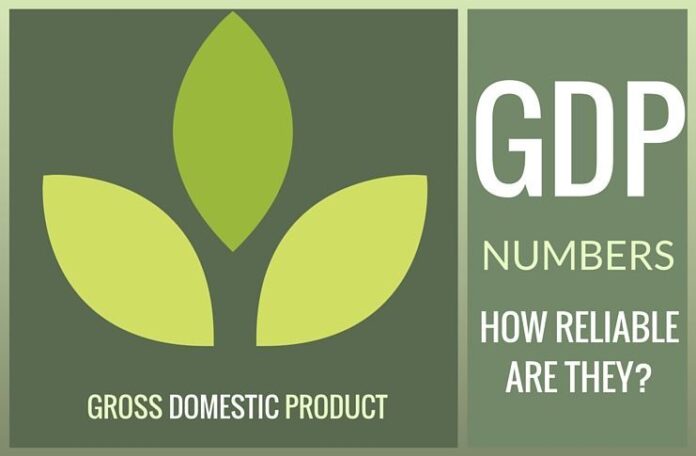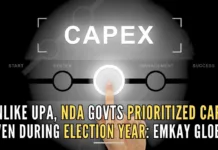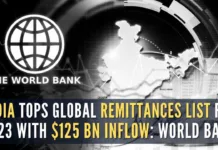
[dropcap color=”#008040″ boxed=”yes” boxed_radius=”8px” class=”” id=””]I[/dropcap]ndia’s economic growth for the financial year 2016 has been estimated at 7.6 per cent as compared with the revised estimate of 7.2 per cent in the previous year, aided mostly by growth in the manufacturing sector.
However, the GDP growth for the third quarter of this financial year slowed to a four-quarter low at 7.3 per cent. In the second quarter, it had grown by 7.7 per cent.
Growth in gross fixed capital formation, a proxy for investment, fell significantly in the third quarter, compared to the second, because of lackluster private investments.
To meet the revised figure of 7.6 per cent growth in the entire current year, the GDP has to increase by 7.8 per cent in the last quarter, to make up for the shortfall in the other quarters.
[dropcap color=”#008040″ boxed=”yes” boxed_radius=”8px” class=”” id=””]E[/dropcap]conomic Affairs Secretary Shaktikanta Das attributed the estimated higher growth to reforms initiated by the government. He also stressed about direction of the economy. When bureaucrats talk about “direction” it means “I am leaving this position and my successor will tell you further”.
The optimism is at odds with weak exports, railway freight, cement production, investment and flat order books that pointed to a weakness in the economy. In nominal terms, however, GDP would grow just 8.6 per cent in the current financial year, which would make the fiscal consolidation exercise of the government a great challenge.
Is the correct picture in nominal or money terms – it will grow at 8.6 % and real or inflation adjusted term at 7.6%?
Also the surprise is about the spurt in manufacturing both in the 3rd quarter as well as 2015-16 which is not reflected in the index of Industrial Production (IIP) which grew only 3.9% in April–November. Somewhere something is amiss.
At Rs 135.67 lakh crore ($2 trillion) GDP, fiscal deficit at 3.9 per cent means Rs 5.29 lakh crore ($78 billion). This is 26,000 crore ($3.8 billion) less than Rs 5.55 lakh crore ($81.7 billion) estimated at the time of the Budget.
[dropcap color=”#008040″ boxed=”yes” boxed_radius=”8px” class=”” id=””]T[/dropcap]he Budget had assumed the nominal GDP growth at 11.5 per cent. The Center’s fiscal deficit already stood at Rs 4.88 lakh crore ($71.87 billion) till December of the current financial year.
The government will have to restrict it within Rs 41,000 crore ($6 billion) (Rs 5.29 lakh crore minus Rs 4.88 lakh crore) in the January-March period. For the next financial year, the government will have to just narrow the gap between the expenditure and the revenue, by over Rs 13,000 crore ($1.91 billion) to retain the target of 3.5 per cent of GDP on the assumption that, in nominal terms, it would also grow the same 8.6 per cent in 2016-17.
This should not have been a problem for the government, caught in a dilemma of sticking to the fiscal consolidation road map or deferring it by a year more. However, the government will have to bear the extra burden of Rs 1.1 lakh crore ($16.2 billion) to implement One Rank One Pension for retired Army personnel and the Seventh Pay Commission recommendations.
More important is the increasing skepticism about the GDP numbers. Even RBI Governor has voiced his concern and of course like a good bureaucrat – later he retracted.
[dropcap color=”#008040″ boxed=”yes” boxed_radius=”8px” class=”” id=””]T[/dropcap]he important point is about the GDP numbers based on new base year of 2011-12 and its reliability. Also CSO has given up the earlier system of organised and unorganised sector. Instead they have household and Non-profit institutions serving households [NPISH] following G-7 style.
The share of Households and NPISH is Gross Value added at base prices in 2013-14 46 % [2nd revised est.] and in 2014-15 it is 45% [first revised estimates]
This is substantially lower than the estimate for unincorporated enterprises.
Also the share of private non-financial corporations at 33% seems to be substantially over estimated, compared to past data of around 12-14%
This needs analysis and we will revert to that in the next installment.
Note:
1. The conversion rate used in this article is 1 USD = 67.90 Rupees.
- नकली खबर लक्षण है, बीमारी नहीं! - April 16, 2018
- Fake News/ Accreditation and Sedition - April 4, 2018
- Two Poisonous Seeds - March 15, 2018










